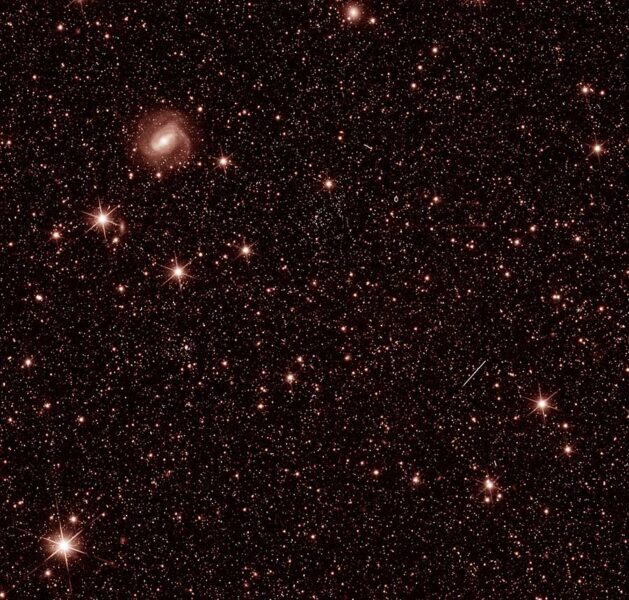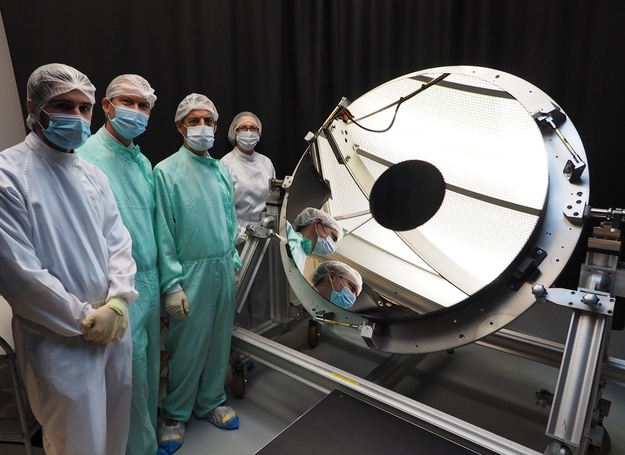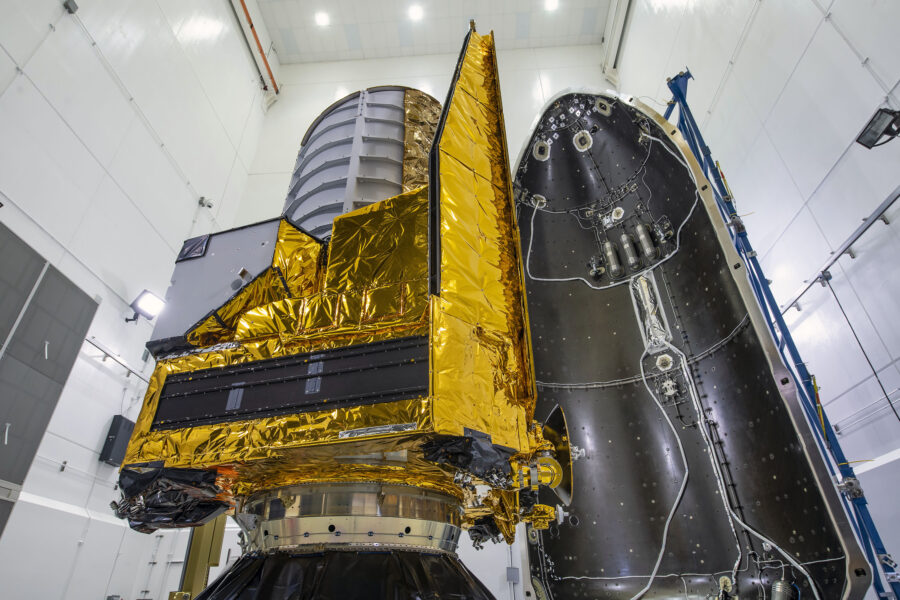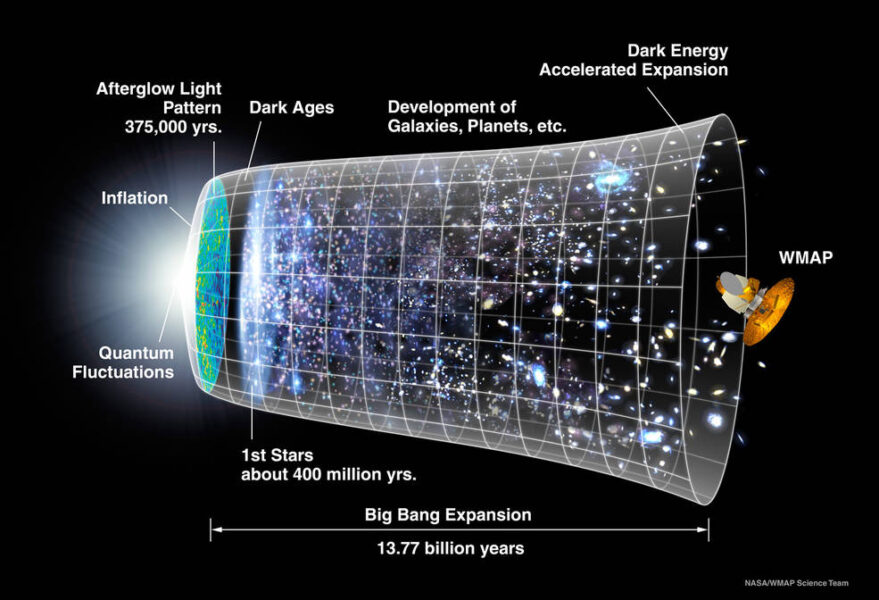The European Space Agency’s new space telescope promises to unlock a key mystery of modern cosmology.
Updates:

ESA / Euclid / Euclid Consortium / NASA, CC BY- SA 3.0 IGO
July 31, 2023: Upon arrival to its orbital spot at L2, Euclid began its commissioning phase, testing its two instruments by taking its first pictures. The glittering field of galaxies indicates that everything is in working order.
A SpaceX Falcon 9 rocket roared skyward over Cape Canaveral Space Force Station today at 11:12 a.m. EDT / 15:12 UT, carrying the European Space Agency’s Euclid telescope into space. The launch was nominal and ESA reported that Euclid was in good health, having separated from the Falcon upper stage 41 minutes after launch.
The mission is headed to a stable Lissajous halo orbit around the Sun-Earth L2 Lagrange point, some 1.1 million kilometers (700,000 miles) beyond the Moon’s orbit in the anti-sunward direction. Other missions circling the L2 point include NASA’s James Webb Space Telescope (JWST) and ESA’s Gaia mission.

ESA
The road to the launch pad was a long one. Euclid was first conceived in 2007 as two separate missions: the Dark Universe Explorer and the Spectroscopic All-Sky Cosmic Explorer. Euclid is a compromise between those two concepts, now a medium-class, 600-million-euro mission that’s part of ESA’s Cosmic Visions program. Euclid’s 1.2-meter mirror and other components are made from silicon-carbide design, a material ideal for the cold of space, as it won’t expand or flex with temperature fluctuations, but difficult to work with. It took several failures, cracked components, and two years longer than planned to build Euclid.

ESA/Safran Reosc
Euclid also employs a simple grating prism, or grism, as a means to simultaneously capture the spectra of galaxies across the 0.7 square-degree field of view of its Near-Infrared Spectrometer and Photometer camera. (Plans for an innovative light-splitting spectrograph, which would have employed thousands of tiny switchable mirrors, had to be scrapped due to added complexity and cost.)
The mission was originally planned to launch on a Soyuz rocket in early 2023, but Russia’s 2022 invasion of Ukraine forced ESA to search for a new launch carrier. Ultimately, SpaceX stepped in to provide a Falcon 9 ride to space.

ESA
NASA is also a partner in the Euclid mission and built infrared detectors for the telescope. Forty U.S. scientists are also participating in the Euclid consortium.
The mission of Euclid is designed to pin down the equation of state for dark energy, the term for whatever is causing the universe's expansion to accelerate. Albert Einstein famously proposed and then rejected a similar force, which he called the cosmological constant. But it wasn’t until 1999 that astronomers actually saw the accelerated expansion while measuring standard candles known as Type Ia supernovae.
Dark energy soon became part the standard model of cosmology, which also includes the effects of dark matter. The model is buttressed by patterns observed in the cosmic microwave background, galaxy clusters, and observations of hundreds of supernovae. These and other measurements show the universe is composed of 5% “normal” (baryonic) matter, 27% dark matter, and 68% dark energy.
This means that the universe is mainly dark matter and dark energy — most of what we can see, such as stars, galaxies and ourselves, is a small piece of the whole. Our current understanding of dark energy puts its equation of state, or w, at a value of –1, which translates to an ever-expanding universe.

NASA / WMAP
The aim of Euclid is to refine this equation of state. If, for example, the equation of state falls slightly below or above –1, or if w actually changes with time rather than remaining constant, such a finding could hint at new and as-yet undiscovered regions of physics. To measure the effects of dark matter and dark energy over cosmic time, Euclid will scan a third of the sky and survey a billion galaxies out to when the universe was only a quarter of its current 13.8-billion-year age.
“Euclid has been designed to accurately measure the expansion history of the universe and the growth of cosmic structures over the past 10 billion years,” says Mike Seiffert (NASA). “We'll do this by measuring the the accurate, three-dimensional positions of tens of millions of galaxies and the precise shapes of over a billion galaxies, and use statistical techniques to understand the universe's expansion and structure.”
To this end, Euclid will use a “step-and-stare” method to cover one-third of the sky. While JWST can see fainter objects at higher resolution, Euclid can cover larger swaths of sky in a shorter period of time.
As this survey probes back those 10 billion years (to a redshift of 2), it will probe the transition from early times, when the effects of gravity dominated over dark energy, to the current era in which dark energy dominates. Euclid's near-infrared spectrometer will measure galaxies' distances and look at how they cluster to measure ripples in the primordial universe known as baryonic acoustic oscillations. In addition, near-infrared brightness measurements and visible-light imaging will measure distortions in galaxies' shapes via gravitational lensing due to the gravitational effects of intervening dark matter.
“Euclid is designed as a survey telescope,” says Seiffert. “It will be efficient at imaging and [gathering] spectral data on distant galaxies in a given field, and after 15 minutes or so it will move on to the next field. In this way, it will build up data on an enormous number of galaxies in over a third of the sky over the course of six years.”
Euclid will soon be joined in the hunt for dark energy by NASA’s Nancy Grace Roman space telescope, launching in 2027, and the Vera Rubin Observatory, expected to see first light in August 2024.
The Euclid mission is now on its way to L2 and should arrive in early August for a three-month-long commissioning phase, followed by a six-year primary mission. Perhaps Euclid and the exciting new generation of telescopes will finally solve one of the major modern mysteries of modern cosmology.
 4
4








Comments
Ludovicus
July 7, 2023 at 5:05 pm
I may be becoming a bit "dimmer" in my days approaching senior years, but I am having a real time of it understanding WHY science has degenerated into using models with fixes rather than physics.
I find it absolutely hard to accommodate current astrophysics with Dark matter and energy comprising the majority of our universe and yet we fervently cannot seemingly find this definitively... Maybe a new range of models are in order? Maybe we should employ our new AI tools without any biases and see what these come up with?
I also am not completely convinced that redshift data has fully accounted for photonic degradation or energy losses properly. (not nec. the "tired photon" model, but something maybe similar need be employed?)
We do not fully understand LONG distance physics, IMO. A photon travelling MPcs of distance may have more interactions than we realize. We do not know this for certain. Those assumptions also change the models we may employ. I have several friends at the UMB (U Manitoba) who aren't totally sure either, and they study this all the time.
So... what is one to do? 🙂
I hope these new tools will come with new open minded approaches so we do not just fit data into models. Having a new "W" may just help that. We will see.
DH,
Edmonton Canada
You must be logged in to post a comment.
Andrew James
July 8, 2023 at 6:03 am
Sorry. I don't agree with your premise at al. Too many times I've seen this nonsense been presented to try to influence people that would not know better. Dark matter is called dark matter because the gravitational influence on galaxies is distorted by its effects. It is clearly gravitation that is causing the discrepancy in the movement and behaviour of these galaxies. If you have a better idea let's hear it. I don't think you do. Doubt is the enemy of science and it is used by those who want to make their worldview valid. Unless you have a better idea I'd like to hear it, but it's far as I can see there is nothing to see that makes me change my mind that dark matter, and to the fact dark energy, is it real. Thanks.
You must be logged in to post a comment.
darkcount
July 9, 2023 at 11:09 am
Sorry, but doubt is NOT the enemy of science; if fact it is fundamental to science. As mentioned by Feynman and others, a good scientist must constantly try to disprove their own hypotheses. Dark matter and energy are hypotheses that try to explain what we can observe at this time.
You must be logged in to post a comment.
Andrew James
July 12, 2023 at 8:29 pm
The doubt I'm talking about is using ideology to justify some other agenda. To sew the seeds of doubt is often done jut to make science and scientists look stupid! The individual posting this comment says: "...I am having a real time of it understanding WHY science has degenerated into using models with fixes rather than physics.”
The existence of dark matter is not a problem using models. Dark matter we believe exists because of gravitation, which is far as I see, comes under the umbrella of physics. E.g. it is a real observational fact. Dark matter is not just based on some idea that is created by deliberate bias.
From experience when I see people saying: "I also am not completely convinced that redshift data has fully accounted for photonic degradation or energy losses properly.” really smacks to me like someone who is denying the fundamental concept of redshifts and yet again circumvent the expansion of the Universe often based on some ideological or religious doctrine. I.e. Looking for a deadly flaw or rather to gain notoriety.
Note: If they were talking about something like gravitational redshifts, the Pound–Rebka experiment, or even the planned ESA's 'Atomic Clock Ensemble in Space (ACES') experiment, I mightn't be so skeptical.
Also I admit, this original comment may not have been made by a doubting naysayer.
You must be logged in to post a comment.
You must be logged in to post a comment.